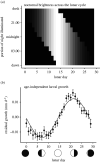Lunar rhythms in growth of larval fish
- PMID: 33434460
- PMCID: PMC7892413
- DOI: 10.1098/rspb.2020.2609
Lunar rhythms in growth of larval fish
Abstract
Growth and survival of larval fishes is highly variable and unpredictable. Our limited understanding of this variation constrains our ability to forecast population dynamics and effectively manage fisheries. Here we show that daily growth rates of a coral reef fish (the sixbar wrasse, Thalassoma hardwicke) are strongly lunar-periodic and predicted by the timing of nocturnal brightness: growth was maximized when the first half of the night was dark and the second half of the night was bright. Cloud cover that obscured moonlight facilitated a 'natural experiment', and confirmed the effect of moonlight on growth. We suggest that lunar-periodic growth may be attributable to light-mediated suppression of diel vertical migrations of predators and prey. Accounting for such effects will improve our capacity to predict the future dynamics of marine populations, especially in response to climate-driven changes in nocturnal cloud cover and intensification of artificial light, which could lead to population declines by reducing larval survival and growth.
Keywords: developmental history; larval growth; lunar periodicity; reef fish; trophic connectivity.
Conflict of interest statement
We declare we have no competing interests.
Figures




References
-
- Hjort J 1914. Fluctuations in the great fisheries of northern Europe viewed in the light of biological research. Rapp. P.-V. Réun. - Cons. Int. Explor. Mer 20, 1–228.
-
- Cushing DH 1990. Plankton production and year class strength in fish populations: an update of the match/mismatch hypothesis. Adv. Mar. Biol. 26, 249–293. ( 10.1016/S0065-2881(08)60202-3) - DOI
-
- Bailey KM, Houde ED. 1989. Predation on eggs and larvae of marine fishes and the recruitment problem. Adv. Mar. Biol. 25, 1–83. ( 10.1016/S0065-2881(08)60187-X) - DOI
-
- Sogard SM 1997. Size-selective mortality in the juvenile stage of teleost fishes: a review. Bull. Mar. Sci. 60, 1129–1157.
Publication types
MeSH terms
Associated data
LinkOut - more resources
Full Text Sources
Other Literature Sources
